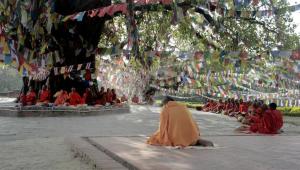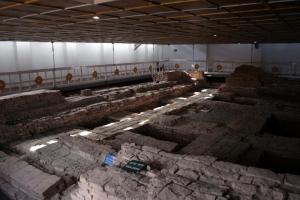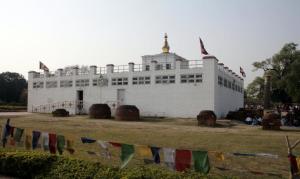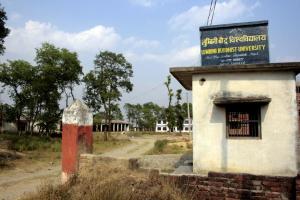Discovery at Nepal site How a hunch led to stunning claim on Buddha birth date

By Ammu Kannampilly18 hours ago
Monks chant under the Bodhi tree, adjacent to the Maya Devi Temple, in Lumbini, some 200 km west of Kathmandu, on April 18, 2013 (AFP Photo/Kyle Knight)
View Gallery Kathmandu (AFP) - The two archaeologists had a hunch that the Buddha's birthplace in southern Nepal held secrets that could transform how the world understood the emergence and spread of Buddhism.
Their pursuit would eventually see them excavate the sacred site of Lumbini as monks prayed nearby, leading to the stunning claim that the Buddha was born in the sixth century BC, two centuries earlier than thought.
Veteran Nepalese archaeologist Kosh Prasad Acharya had carried out excavations in Lumbini before in the early 1990s, when Nepal was still ruled by a king and a Maoist insurgency had yet to kick off.
The project ended in 1996 but Acharya remained unsatisfied with the results.
"My belief was that there was another cultural deposit below, which we had not uncovered," the 62-year-old told AFP.
He headed back to his government job in the capital Kathmandu and waited to retire, restless to return to Lumbini.
View gallery

Monks chant under the Bodhi tree, adjacent to the Maya Devi Temple in Lumbini, some 200 km west of K …
The Buddha's birthplace was lost and overgrown by jungle before its rediscovery in 1896, when the presence of a third century BC pillar bearing inscriptions allowed historians to identify it as Lumbini.
Since then, it has been designated a UNESCO world heritage site, visited by millions of Buddhists every year, with numbers expected to rise exponentially in the following decades.
Acharya had just retired from his last job, as the director general of the department of archaeology, when UNESCO asked him to co-direct an investigation of Lumbini's foundations.
The cultural organisation asked Acharya and his longtime collaborator, Robin Coningham, Britain's leading South Asian archaeologist, to head a team that would examine the site so conservators could develop it for growing numbers of visitors.
"In 2010, our first year there, we were pretty much the handmaidens to the conservators," Coningham told AFP in a phone interview from his office at Britain's Durham University, which helped fund the UNESCO project.
View gallery

General view of the excavations at the Maya Devi Temple in Lumbini, some 200 km west of Kathmandu, p …
"The Eureka moment came in 2011, when we came across a brick temple located below the existing Asokan temple, and below that a sort of void.
"It became clear then that there was much more to this excavation."
Over the next two years, archaeologists, geophysicists and hired workmen from Nepal and Britain worked on the site, digging in the presence of meditating monks and nuns.
"It was a very moving, very special experience to dig for traces while pilgrims prayed and paid homage," Acharya said.
They dug for a few weeks each year and sent the samples to laboratories for analysis.
View gallery

Visitors gather at the Maya Devi Temple in Lumbini, some 200 km west of Kathmandu, on April 17, 2013 …
Radiocarbon and optically stimulated luminescence techniques were used to date fragments of charcoal and grains of sand found at the site.
The archaeologists also found holes, apparently meant to secure posts, in the open void below the brick temple.
"The intact holes suggested that whoever had built the brick temple had taken care not to damage the ancient structure below, suggesting the site was always considered holy," Coningham said.
Lab tests confirmed the existence of roots within the void below the brick structure, suggesting it may have been a shrine where a tree once grew, possibly the hardwood sal tree under which many believe the Buddha was born.
The discovery, revealed in November, sparked huge excitement, but some historians have urged caution, saying the ancient tree shrine could have been built by pre-Buddhist believers.
View gallery

The entrance to the 'Lumbini Buddhist University', some 200 km west of Kathmandu, on April 1 …
"The worship of trees, often at simple altars, was a ubiquitous feature of ancient Indian religions," Julia Shaw, a lecturer in South Asian archaeology at University College London told National Geographic's online edition.
"It is also possible that what is being described represents an older tree shrine quite disconnected from the worship of the historical Buddha," Shaw added.
According to Coningham, however, if the Buddhists had appropriated the tree shrine from non-Buddhists, the site would not have survived relatively unscathed.
"Also, the inscriptions at Bodhgaya (where the Buddha achieved enlightenment) reveal a thriving culture of tree worship, which suggests continuity," he added.
Much of what is known about the Buddha's life has its origins in oral tradition. The earliest decipherable written records in the region, the inscriptions of India's Buddhist emperor Asoka, are dated about 250 BC.
Prior to this discovery, most scholars said that the Buddha -- who renounced material wealth to embrace and preach a life of non-attachment -- lived during the fourth century BC, founding a religion that now counts 500 million followers.
Buddhists in Nepal and Sri Lanka, however, have always believed that the sage was born around 623 BC, a date that now seems more accurate.
"It's one of the great puzzles, this discovery reveals the endurance of oral traditions," Coningham said.
"This is one of those very rare times when tradition, belief and archaeology all come together."
 Acting on a hunch, two archaeologists dig deep into a sacred site in Nepal and make a startling find.
Acting on a hunch, two archaeologists dig deep into a sacred site in Nepal and make a startling find.
The Eureka moment